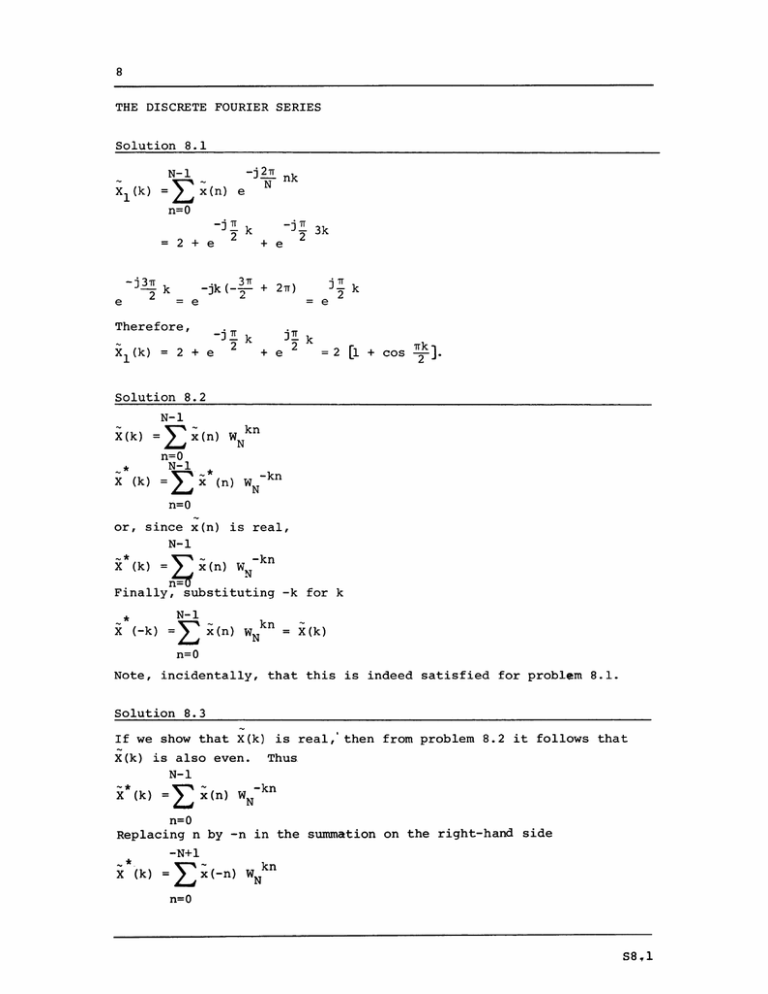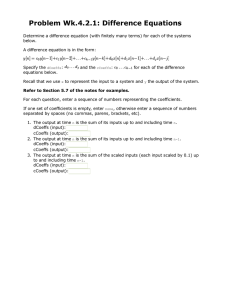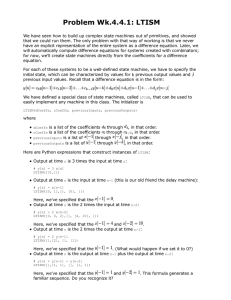Document 13475405
advertisement

8 THE DISCRETE FOURIER SERIES Solution 8.1 N-1 j2 nk N x(n) e X1 (k) = n=o - k 2 + e 2 + e e -jk (-3-7+ 2Tr) k 2 3k 2 Therefore, . . - X1 (k) = 2 + e k j 7i k 2 ] + e 2 k =2[1 +cos ). Solution 8.2 N-1 X(k) = x(n) W kn n=o * N-1 X (k) = x (n) WN n=o or, since x(n) is real, N-1 X (k) = x(n) WN n= Finally, substituting -k for k (-k) = N-1 k x(n) WN = X(k) n=0 Note, incidentally, that this is indeed satisfied for problem 8.1. Solution 8.3 If we show that X(k) is real,' then from problem 8.2 it follows that X(k) is also even. Thus N-1 x(n) WN X (k) n=0 Replacing n by -n in the summation on the right-hand side -N+l x (-n) WN (k) = n=O S8,1 or since x(n) is even -N+l x*(k) x(n) WN n=0 Finally, since x(n) is periodic the limits on the summation can be replaced by the interval 0 to N-l. Thus X*(k) = X(k), i.e. X(k) is real. Solution 8.4 Since x(n) is periodic with period 10, X(k) is also periodic with (i) period 10. Thus (i) is true. Since x(n) is real, X*(k) = X(-k). (ii) In order for the stated property to also be true, X(k) must be real, which requires that x(n) be even, which is not the case. Thus (ii) is not true. N-1 i(0) (iii) = x(n) = 0. Thus (iii) is true. n=0 A27T (iv) X(k) e3 5 is the Fourier series for x(n + 2). we note that x(n + 2) is not an even function. Thus k2Tr X(k) ej -jk27r 5 ~ X(k) e is not real. However, x(n - 2) is an even sequence and thus is real Solution 8.5 See Figure S8.5-1 on next page. S8.2 From the figure x1(Mf) *** ... x2 (rM) *000I p p p p I - p m x2 (1-m) 0*0 000 p p p p *1 10 x3 (n) #1 ***5 ... Figure S8.5-1 Solution 8.6 The Discrete Fourier series coefficients of X(k) would be defined as N-l y(n) X(k) WNkn = k=0 x(n) is given by ~ x(n) N-1 X(k) = l E 1 k -kn *N k=0 thus y(n) = N x(-n). S8.3 Solution 8.7 The time origin can be chosen such that all the X(k) are real if x(n) can be shifted to be an even function. It can for sequence (b) but not for the others. (a) (b) This requires that the time origin be chosen so that x(n) is odd. This cannot be done for any of the sequences. Solution 8.8 N-1 X1(k) = x(n) WN n=0 2N-l x2 (k) = kn x(n) W 2 N n=0 N-1 = n=O kn x(n) W2N N-1 + k(n+N) x(n + N) W 2 N n=O N or, since x(n) is periodic with period N and W2N N-l X 2 (k) = x(n) W2Nkn [1 + (-1)k] n=O N-1 [=+( -)k] (n) W2kn n= n=0 Thus, for k odd, X2 (k) = 0. 0 k For k even, W 2 N and N-1 E X(n) WNn(k/ 2 ) 2 = (k) X2 n=0 = 2 X 1 (k/2) S8.4 k even. n(k/2) WN MIT OpenCourseWare http://ocw.mit.edu Resource: Digital Signal Processing Prof. Alan V. Oppenheim The following may not correspond to a particular course on MIT OpenCourseWare, but has been provided by the author as an individual learning resource. For information about citing these materials or our Terms of Use, visit: http://ocw.mit.edu/terms.





